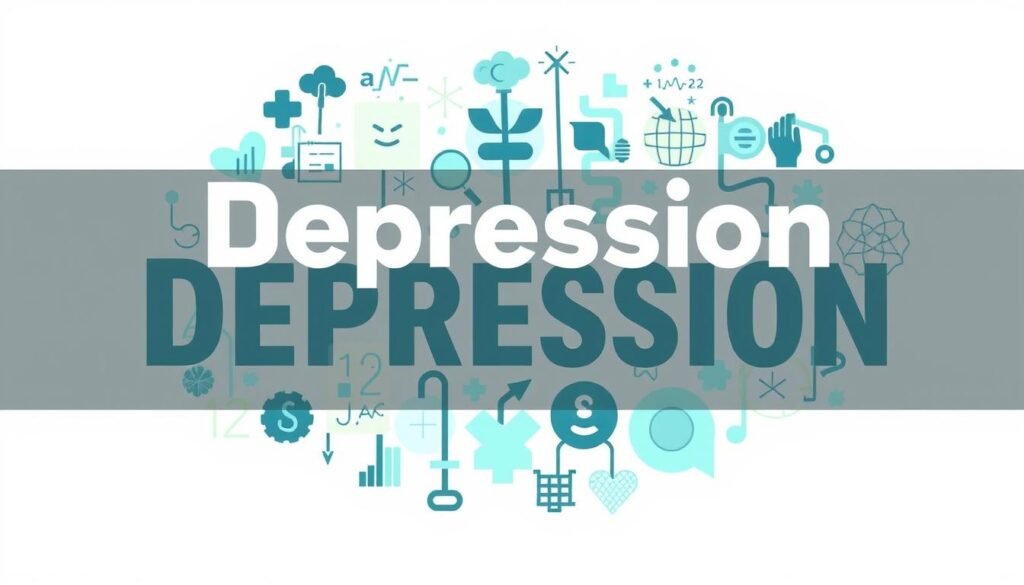Nearly 21 million adults in the United States have had at least one depressive episode. This fact points to the need for precise medical billing, especially in mental health. The ICD 10 code for depression is key for doctors to bill correctly for mental health issues.
This guide gives insights into the ICD 10 codes for depression, including the F32.A code. The International Statistical Classification of Diseases (ICD) and the DSM-5 help doctors diagnose and bill correctly. They ensure the right diagnosis, treatment, and billing for healthcare services.
Key Takeaways
- The ICD-10-CM code F32.A became effective on October 1, 2024.
- 9.5 percent of American adults suffer from a depressive disorder annually.
- F32.A is used for billing purposes related to single episodes of various types of depression.
- Depression coding is crucial for ensuring appropriate healthcare reimbursement.
- Accurate mental health coding significantly influences patient treatment and outcome tracking.
- The DSM-5 provides essential guidance on diagnostic criteria for depression.
Understanding Depression and Its Impact
Depression is a big problem for personal emotional well-being and society. It leads to constant sadness, tiredness, and losing interest in fun activities. Around 9.5% of Americans struggle with it each year. This info comes from many depression statistics. The issue is complex, mixing emotional and psychological parts with social ones. Realizing this helps us see how deeply it affects mental health.
People with depression face more than just sadness. Their relationships can get worse, causing loneliness and being misunderstood. Also, it makes them less productive at work. Employers notice when their workers are not as active or doing well because of depression. This shows how depression’s impact goes beyond just the person suffering.
It’s important to diagnose depression correctly. Health experts need to spot the main signs, like being sad for two weeks or more, eating differently, and thinking of hurting oneself. Knowing about these signs is key. It helps a lot in getting help.
Overall, dealing with depression is tough. It needs us to look at the big picture of its effects on people and communities. Health workers are especially important in this. They help us understand and fight the way depression mixes with mental health.
What is the ICD 10 Code for Depression?
The ICD 10 code for depression is vital for handling depressive disorders. F32.2 is a key code. It marks major depression, a single episode, severe without psychotic features. Precise diagnosis coding impacts patient care and the money side of medical treatment.
The F32 series focuses on depressive episodes, like major and psychogenic depression. This is part of the broader F01-F99 range. These codes cover mental, behavioral, and neurodevelopmental disorders. Starting October 1, 2024, F32.2 will represent patients’ conditions more accurately. This leads to better treatment plans. Before, F32.9 was the go-to code, which caused wrong high stats for major depression.
For accurate mental health terminology, documentation must detail the depression type and episode. Symptoms should last two weeks for a right diagnosis. Also, ongoing support is crucial for those with long-term or repeated depression. This ensures they get the right help and care.
Tools like the PHQ-9 are helpful for doctors. They make it easier to check and track symptoms. The questionnaire’s scores aid in diagnosing and keeping an eye on depression. This shows how important depression classification is in medicine.
Types of Depression Covered by ICD 10 Codes
It’s key to know the depression types ICD 10 codes cover for right diagnosis and treatment. This system lists many types of depression, like major depressive disorder and different depression subtypes.
The main code, F33, is for major depressive disorder, recurrent. There are specific codes for how severe it is and its traits:
| ICD 10 Code | Description |
|---|---|
| F33.0 | Major depressive disorder, recurrent, mild |
| F33.1 | Major depressive disorder, recurrent, moderate |
| F33.2 | Major depressive disorder, recurrent severe without psychotic features |
| F33.3 | Major depressive disorder, recurrent, severe with psychotic symptoms |
| F33.4 | Major depressive disorder, recurrent, in remission |
| F33.41 | Major depressive disorder, recurrent, in partial remission |
| F33.8 | Other recurrent depressive disorders |
| F33.9 | Major depressive disorder, recurrent, unspecified |
Other cases include seasonal affective disorder and vital depression. Episodes can last from three to twelve months. They usually last about six months. Recurrent depressive disorder happens more in women across cultures.
Knowing these depression ICD 10 codes helps doctors tailor better treatments. This ensures better care and correct billing. It’s vital for managing depression effectively.
Major Depressive Disorder ICD 10
Major depressive disorder (MDD) involves serious psychological symptoms. These symptoms greatly impact daily life. It’s classified under the F32 and F33 ICD 10 codes. These codes help in understanding the severity—mild, moderate, and severe. Knowing these codes is critical for doctors treating depression.
Over 20 million American adults suffer from clinical depression. MDD usually starts between 15 and 30 years old. Women are affected more than men. Among cancer patients, 15-25% show depressive symptoms. This shows the importance of accurate diagnosis and treatment.
Below is a table summarizing key ICD 10 codes associated with major depressive disorder:
| ICD 10 Code | Description |
|---|---|
| F32.1 | Major depressive disorder, single episode, moderate |
| F32.9 | Major depressive disorder, single episode, unspecified |
| F33.1 | Major depressive disorder, recurrent, moderate |
| F33.9 | Major depressive disorder, recurrent, unspecified |
Switching to the ICD-10-CM coding system has changed how doctors handle MDD. This change became important for billing, starting October 1, 2015. It’s vital to understand F32 and F33 codes. They cover different depressive disorders. This helps clinicians meet each patient’s specific needs.

Clinical Depression ICD 10 Code Explained
Clinical depression falls under the F32 depression codes in the ICD 10 system. It’s key for correctly documenting a person’s mental health. Proper use of these codes allows for right treatment and aids in insurance processes.
A large review looked into how well depression is defined using ICD codes. They started with 2,014 abstracts and closely reviewed 36. This effort shows the research dedicated to refining these definitions. Tests on 4,008 medical records led to new definitions. These are more sensitive, detecting depression better than before.
The new tests for depression had over 99% specificity. Their ability to predict true depression cases was above 89%. Similarly, they correctly identified non-cases over 91% of the time. This accuracy ensures patients are correctly diagnosed. This leads to better management and recovery paths for them.
There are many ways to learn about and manage clinical depression. Resources and expert advice are widely available. For more guidance, visit this detailed guide on finding depression help here.
Depression Diagnosis Codes and Their Importance
Correct diagnosis codes for depression are vital in the healthcare world. Codes like F32 and F33 from the ICD-10-CM are crucial. They ensure accurate billing and help with insurance claims.
These codes also shape treatment choices and the recording of healthcare details. For example, code F32.2 is for severe depression without psychosis. It shows the need for current coding.
Wrong codes can cause big problems, like loss of money and poor patient care. Knowing how to use these codes right can prevent these issues. The F32 codes describe different levels of depression, helping doctors bill correctly.
About 9.5 percent of U.S. adults face depression yearly. It’s important for healthcare workers to know these codes well. As many as 35 percent of people with depression have it come back within 15 years. This makes a strong coding system a must for ongoing care.

| Diagnosis Code | Description | Effective Date | Related Group |
|---|---|---|---|
| F32.2 | Major depressive disorder, single episode, severe without psychotic features | October 1, 2024 | MS-DRG 885 |
| F32.A | Depression, unspecified | October 1, 2024 | MS-DRG 881 |
ICD 10 Code for Depression: Key Categories
Learning about the ICD 10 key categories helps improve medical documentation and billing. These categories cover different aspects of a patient’s mental state. Depression is classified under various types, like acute or recurring mood disorders.
The code F32.9 is for major depressive disorder, single episode, unspecified. It covers conditions like unspecified depression and major depression, NOS. The codes from F32.0 to F32.5 describe the illness’s severity and recovery stages. Tools like Valant EHR help doctors organize and accurately record mental health codes.
Depression is common among people with chronic pain, being four times more likely. Accurate coding is crucial, aiding therapists in providing better care. This is important for adopting value-based care approaches.
Tools such as the PHQ-2 and PHQ-9 are key in early depression detection. This allows for immediate action. Therapists and billing experts must use EMR tools and databases like ICD10data. They improve code accuracy for various conditions.
Depressive Episodes ICD 10 – What You Need to Know
Understanding depressive episodes is key for right diagnosis and treatment. The depressive episodes ICD 10 are mainly in the F32 category. This category covers depression from mild to severe. Knowing the type and severity of depression is crucial for correct medical coding.
Symptoms like ongoing sadness, lack of energy, and losing interest in usual activities are common. These signs are crucial for spotting depressive episodes. Recognizing them helps in planning effective treatment and care, depending on how severe the symptoms are.
Doctors need to follow certain coding guidelines. For example, F32.9 stands for Major Depressive Disorder, single episode, unspecified. F32.8 covers other types of depressive episodes, like premenstrual dysphoric disorder. Each sub-code under F32 helps in diagnosing and choosing the right treatment strategy.
| ICD-10 Code | Description | Severity Level |
|---|---|---|
| F32.0 | Mild depressive episode | Mild |
| F32.1 | Moderate depressive episode | Moderate |
| F32.2 | Severe depressive episode without psychotic features | Severe |
| F32.3 | Severe depressive episode with psychotic features | Severe |
| F32.8 | Other specified depressive episodes | Variable |
| F32.9 | Major depressive disorder, single episode, unspecified | Variable |
Coding for depressive episodes ICD 10 needs careful attention to symptoms and other issues. This is essential for handling depression well. It shows why a detailed checkup and correct coding matter.
Severe Depression ICD 10 Code Breakdown
Severe depression falls under the ICD 10 code system, tagged as F32.2 for severe episodes without psychotic features. This code is key for right diagnosis and care. Knowing the specifics of this code helps doctors provide top-notch treatment.
The ICD-10-CM system has several codes for depression’s levels of severity. For example, F33.1 is for recurring moderate depression, while F32.3 is for severe episodes with psychotic features. These codes help plan treatment and impact how care is paid for. Wrong codes can lead to poor care plans.
| ICD 10 Code | Description |
|---|---|
| F32.2 | Severe major depressive episode without psychotic features |
| F32.3 | Severe major depressive episode with psychotic features |
| F33.1 | Recurrent moderate major depressive disorder |
| F33.0 | Recurrent major depressive disorder, current episode mild |
| F33.3 | Recurrent major depressive disorder, current episode severe |
It’s crucial to code severe depression accurately to document its recurring nature. Clinicians can use official coding resources for guidance. Understanding coding details helps doctors make customized treatment plans.
Recurrent Depressive Disorder ICD 10
The F33 codes classify the recurrent depressive disorder ICD 10. They are key for diagnosing and managing major depression that happens again and again. These codes help make sure patients get the care they need over time. They also support insurance payments.
Understanding these codes is vital for tracking a patient’s mental health. This ensures they receive the right support.
Starting October 1, 2024, the ICD-10 code F33.8 will cover other recurrent depressive disorders. This includes short-term depression episodes. This update is crucial for both treating patients and the billing process. Making these changes in healthcare systems helps address the needs of those with this disorder. Learn more about the F33.42 code at this link.
Coding for relapse in recurrent depression poses challenges. Proper coding ensures ongoing care and better support for those with chronic depression. The codes F33.9 and F33.0 address depression’s varying severity and symptoms. This boosts the value of precise coding. Since October 1, 2015, specific ICD-10-CM codes are required for billing, ensuring continuous treatment coverage.

Treating recurrent depression involves many strategies. They combine medication, therapy, and lifestyle changes. Good communication between doctors and patients improves treatment success. This emphasizes the importance of antidepressants and therapy in recovery. For more on available medications, check out this guide.
| ICD 10 Code | Description | Effective Date |
|---|---|---|
| F33.0 | Recurrent major depressive disorder, mild | October 1, 2024 |
| F33.8 | Other recurrent depressive disorders | October 1, 2024 |
| F33.9 | Recurrent depressive disorder, unspecified | October 1, 2024 |
Importance of Accurate Coding in Medical Billing
Accurate coding is vital in medical billing, especially for mental health. Almost 20% of adults in the U.S. face mental health issues yearly. Correct coding ensures they receive proper reimbursement and follow healthcare laws.
The need for precise coding is clear due to more external audits. In 2024, these audits doubled from the previous year. The stakes are high with $11.2 million at risk, affecting healthcare providers’ finances.
New mental health issues, like prolonged grief disorder, have surfaced. They require current ICD-10 codes. Modern coding tools and electronic records help choose the right codes. This results in accurate billing for conditions such as:
- F32.0 – Major depressive disorder, single episode, mild
- F32.1 – Major depressive disorder, single episode, moderate
- F32.2 – Major depressive disorder, single episode, severe without psychotic features
- F32.3 – Major depressive disorder, single episode, severe with psychotic features
- F41.0 – Panic disorder [episodic paroxysmal anxiety]
To ensure payment accuracy, follow rules like the No Surprises Act. Ignoring these can lead to penalties. Key steps in accurate coding include:
- Accurate Diagnosis
- Clear Documentation
- Appropriate CPT Codes
- Timely Submissions
In mental health services, accurate coding is essential. It supports correct reimbursements and quality care. This ensures patients receive the right diagnoses and treatments.
Common Mistakes in Coding Depression
Understanding the mistakes made in coding depression can really improve medical billing and patient care. Mistakes often lead to billing inaccuracies and wrong treatment plans. It’s critical to correctly identify how severe a patient’s depression is to treat them right.
Another big issue is using the wrong billing codes. This usually happens with repeated episodes of depression. These common errors in coding depression come from not documenting patient meetings well, which is key for correct coding. Correctly applying CPT codes when coding therapy sessions and other services is very important.
Knowing each patient’s symptoms and behavior is also key in documenting mental health. Good documentation helps avoid mental health documentation errors. This keeps coding accurate and follows ethical guidelines.
To help with coding, using mental health billing software can lower mistakes. Regular audits on mental health coding can find problems. This improves how coding is done and supports better patient care for those with depression.
Conclusion
This article shows how important the ICD 10 depression code is in health care. It helps with payment processes and raises the quality of care for mental health patients. Since depression affects a lot of people worldwide, accurate coding is crucial.
Doctors and healthcare workers need to keep up with coding updates. They must learn all about the ICD 10, including how to tell the difference between mild, moderate, and severe depression. Good training and following the coding rules can prevent wrong classifications and treatment failures.
Knowing the coding system for depression well helps doctors give better mental health care. Using best practices in mental health not only makes billing easier but also ensures patients get the care they need. This approach helps everyone involved.